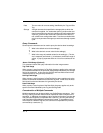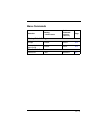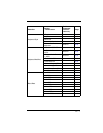
12 - 2
Data The new value for a menu setting, identified by the Tag and Sub-
Tag.
Storage A single character that specifies the storage table to which the
command is applied. An exclamation point (!) performs the com-
mand’s operation on the device’s volatile menu configuration table.
A period (.) performs the command’s operation on the device’s
non-volatile menu configuration table. Use the non-volatile table
only for semi-permanent changes you want saved through a power
cycle.
Query Commands
Several special characters can be used to query the device about its settings.
^ What is the default value for the setting(s).
? What is the device’s current value for the setting(s).
* What is the range of possible values for the setting(s). (The de-
vice’s response uses a dash (-) to indicate a continuous range of
values. A pipe (|) separates items in a list of non-continuous val-
ues.)
:Name: Field Usage (Optional)
This command returns the query information from the image scanner.
Tag Field Usage
When a query is used in place of a Tag field, the query applies to the
entire
set
of commands available for the particular storage table indicated by the Storage
field of the command. In this case, the SubTag and Data fields should not be
used because they are ignored by the device.
SubTag Field Usage
When a query is used in place of a SubTag field, the query applies only to the
subset of commands available that match the Tag field. In this case, the Data
field should not be used because it is ignored by the device.
Data Field Usage
When a query is used in place of the Data field, the query applies only to the
specific command identified by the Tag and SubTag fields.
Concatenation of Multiple Commands
Multiple commands can be issued within one Prefix/Storage sequence. Only
the Tag, SubTag, and Data fields must be repeated for each command in the
sequence. If additional commands are to be applied to the same Tag, then the
new command sequence is separated with a comma (,) and only the SubTag
and Data fields of the additional command are issued. If the additional com-
mand requires a different Tag field, the command is separated from previous
commands by a semicolon (;).


















